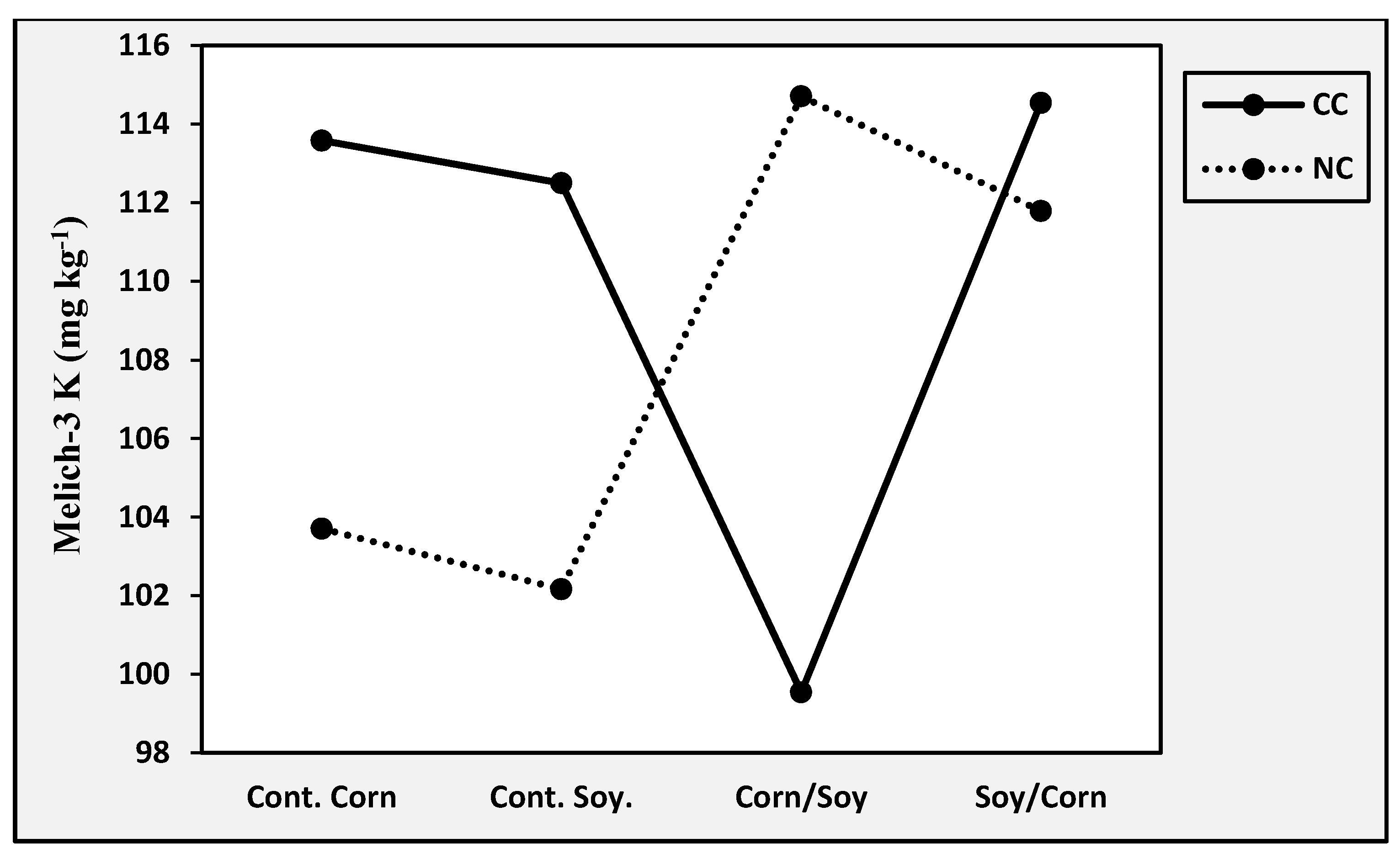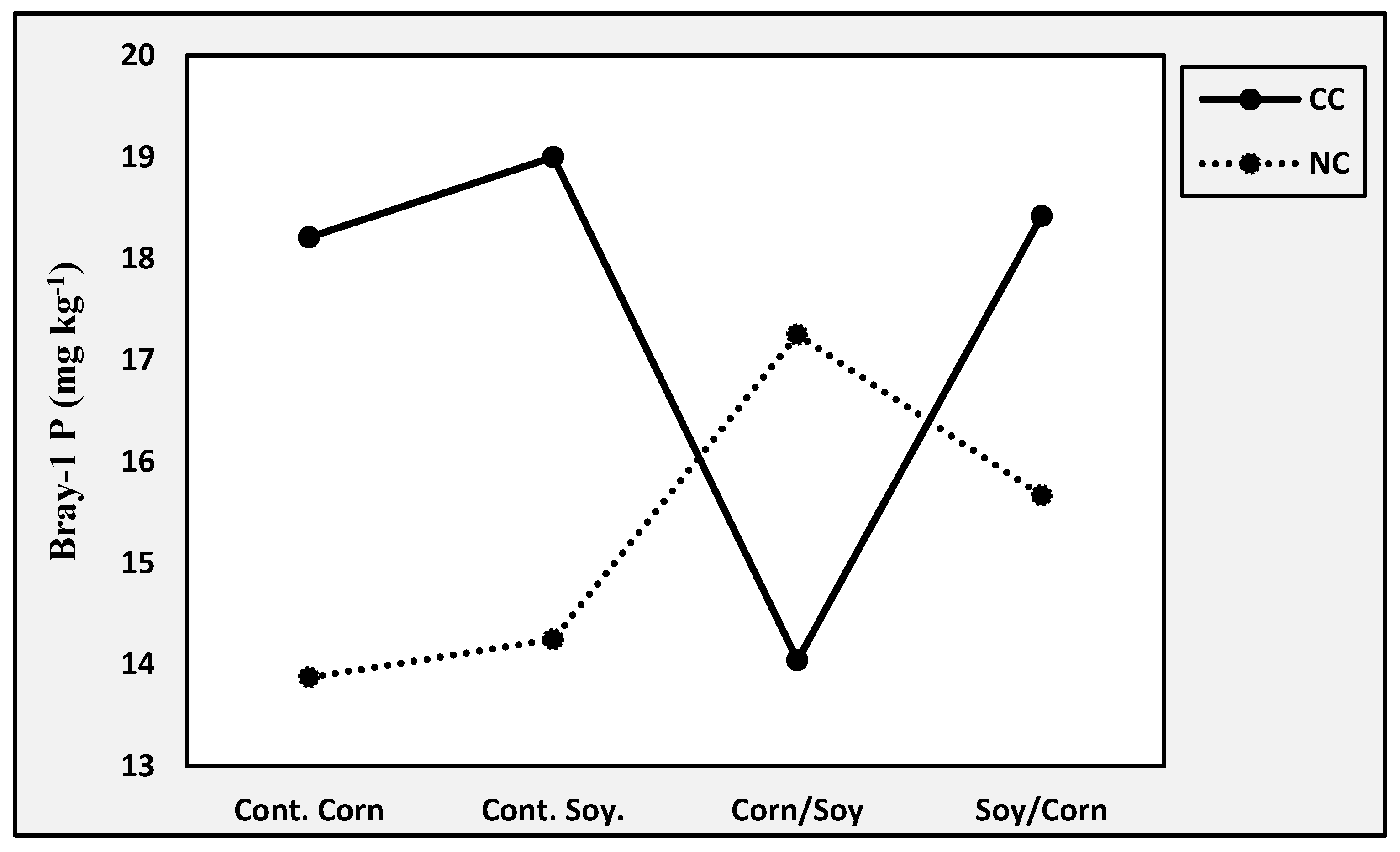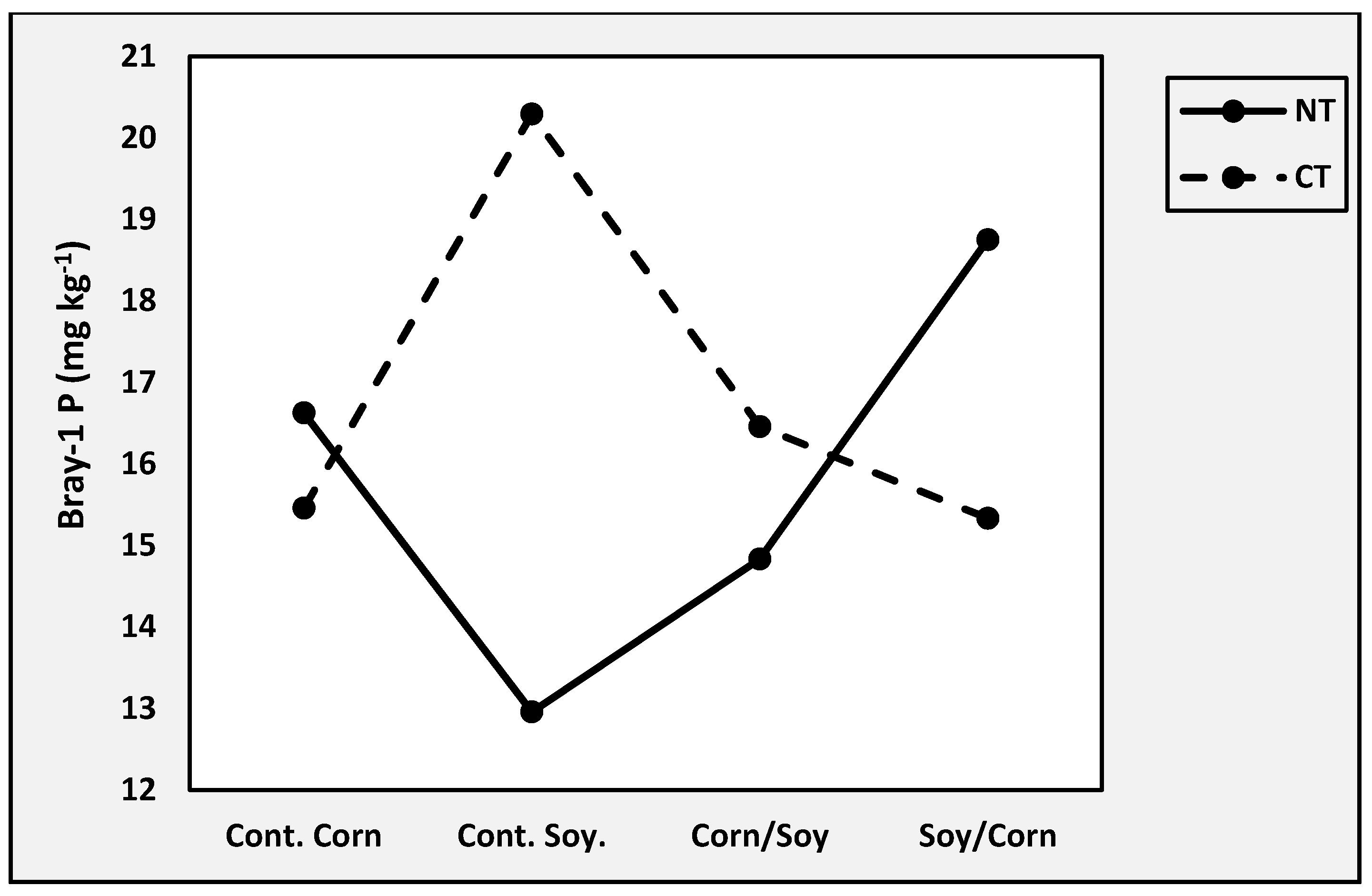Influence of Cover Crop, Tillage, and Crop Rotation Management on Soil Nutrients
Abstract
1. Introduction
2. Materials and Methods
2.1. Site Description and Experimental Design
2.2. Soil Sampling and Analysis
2.3. Statistical Analysis
3. Results
4. Discussion
5. Conclusions
Author Contributions
Funding
Conflicts of Interest
References
- Lal, R.; Kimble, J.M. Conservation tillage for carbon sequestration. Nutr. Cycl. Agroecosyst. 1997, 49, 243–253. [Google Scholar] [CrossRef]
- Bindraban, P.S.; van der Velde, M.; Ye, L.; van den Berg, M.; Materchera, S.; Kiba, D.I.; Tamene, L.; Ragnarsdottir, K.V.; Jongschaap, R.; Hoogmoed, M.; et al. Assessing the impact of soil degradation on food production. Curr. Opin. Environ. Sustain. 2012, 4, 478–488. [Google Scholar] [CrossRef]
- Llewellyn, R.S.; D’Emden, F.H.; Kuehne, G. Extensive use of no-tillage in grain growing regions of Australia. Field Crop. Res. 2012, 132, 204–212. [Google Scholar] [CrossRef]
- Hendrix, P.F.; Parmelee, R.W.; Crossley, D.A., Jr.; Coleman, D.C.; Odum, E.P.; Groffman, P.M. Detritus food webs in conventional and no-tillage agroecosystems. BioScience 1986, 36, 374–380. [Google Scholar] [CrossRef]
- Prinsloo, M.A.; Wiltshire, G.H.; du Preez, C.C. Loss of nitrogen fertility and its restoration in some Orange Free State soils. S. Afr. J. Plant Soil 1990, 7, 55–61. [Google Scholar] [CrossRef]
- Christopher, S.F.; Lal, R. Nitrogen management affects carbon sequestration in North American cropland soils. Crit. Rev. Plant Sci. 2007, 26, 45–64. [Google Scholar] [CrossRef]
- Haruna, S.I.; Nkongolo, N.V. Tillage, cover crop and crop rotation effects on selected soil chemical properties. Sustainability 2019, 11, 2770. [Google Scholar] [CrossRef]
- Thomas, G.A.; Dalal, R.C.; Standley, J. No-till effects on organic matter, pH, cation exchange capacity and nutrient distribution in a Luvisol in the semi-arid subtropics. Soil Tillage Res. 2007, 94, 295–304. [Google Scholar] [CrossRef]
- Omonode, R.A.; Gal, A.; Stott, D.E.; Abney, T.S.; Vyn, T.J. Short-term versus continuous chisel and no-till effects on soil carbon and nitrogen. Soil Sci. Soc. Am. J. 2006, 70, 419–428. [Google Scholar] [CrossRef]
- Omay, A.B.; Rice, C.W.; Maddux, L.D.; Gordon, W.B. Changes in soil microbial and chemical properties under long-term crop rotation and fertilization. Soil Sci. Soc. Am. J. 1997, 61, 1672–1680. [Google Scholar] [CrossRef]
- Sainju, U.M.; Whitehead, W.F.; Singh, B.P. Agricultural management practices to sustain crop yields and improve soil and environmental qualities. Sci. World J. 2003, 3, 768–789. [Google Scholar] [CrossRef]
- Gregorich, E.G.; Liang, B.C.; Ellert, B.H.; Drury, C.F. Fertilization effects on soil organic matter turnover and corn residue c storage. Soil Sci. Soc. Am. J. 1996, 60, 472–487. [Google Scholar] [CrossRef]
- Zaibon, S.; Anderson, S.H.; Thompson, A.L.; Kitchen, N.R.; Gantzer, C.J.; Haruna, S.I. Soil water infiltration affected by topsoil thickness in a row crop and switchgrass production systems. Geoderma 2017, 286, 46–53. [Google Scholar] [CrossRef]
- Cercioglu, M.; Anderson, S.H.; Udawatta, R.P.; Haruna, S.I. Effects of cover crop and biofuel crop management on computed tomography-measured pore paramters. Geoderma 2018, 319, 80–88. [Google Scholar] [CrossRef]
- Haruna, S.I.; Nkongolo, N.V.; Anderson, S.H.; Eivazi, F.; Zaibon, S. In situ infiltration as influenced by cover crop and tillage management. J. Soil Water Conserv. 2018, 73, 164–172. [Google Scholar] [CrossRef]
- Tilman, D.; Cassman, K.G.; Matson, P.A.; Naylor, R.; Polasky, S. Agricultural sustainability and intensive production practices. Nature 2002, 418, 671–677. [Google Scholar] [CrossRef]
- Wyland, L.J.; Jackson, L.E.; Chaney, W.E.; Klonsky, K.; Koike, S.T.; Kimple, B. Winter cover crops in a vegetable cropping system: Impacts on nitrate leaching, soil water, crop yield, pests and management costs. Agric. Ecosyst. Environ. 1996, 59, 1–17. [Google Scholar] [CrossRef]
- Dabney, S.M.; Delgado, J.A.; Reeves, D.W. Using winter cover crops to improve soil and water quality. Commun. Soil Sci. Plant Anal. 2001, 32, 1221–1250. [Google Scholar] [CrossRef]
- Reddy, K.N.; Zablotowicz, R.M.; Locke, M.A.; Koger, C.H. Cover crop, tillage, and herbicide effects on weeds, soil properties, microbial populations, and soybean yield. Weed Sci. 2003, 51, 987–994. [Google Scholar] [CrossRef]
- Gomez, J.A.; Guzman, M.G.; Giraldez, J.V.; Fereres, E. The influence of cover crops and tillage on water and sediment yield, and on nutrient, and organic matter losses in an olive orchard on a sandy loam soil. Soil Tillage Res. 2009, 106, 137–144. [Google Scholar] [CrossRef]
- Abdollahi, L.; Munkholm, L.J. Tillage systems and cover crop effects on soil quality: I. Chemical, mechanical, and biological properties. Soil Sci. Soc. Am. J. 2014, 78, 262–270. [Google Scholar] [CrossRef]
- Kladivko, E.J.; Helmers, M.J.; Abendroth, L.J.; Herzmann, D.; Lal, R.; Castellano, M.J.; Mueller, D.S.; Sawyer, J.E.; Anex, R.P.; Arritt, R.W.; et al. Standard research protocols enable transdisciplinary research of climate variation impacts in corn production systems. J. Soil Water Conserv. 2014, 69, 532–542. [Google Scholar] [CrossRef]
- Haruna, S.I.; Nkongolo, N.V. Effects of tillage, rotation and cover crop on the physical properties of a silt-loam soil. Int. Agrophys. 2015, 29, 137–145. [Google Scholar] [CrossRef]
- Haruna, S.I.; Nkongolo, N.V. Variability of soil physical properties in a clay-loam soil and its implication on soil management practices. Int Sch Res Notices. 2013, 2013, 1–8. [Google Scholar] [CrossRef]
- Haruna, S.I.; Nkongolo, N.V. Spatial and fractal characterization of soil chemical properties and nutrients across depths in a clay-loam soil. Commun Soil Sci Plant Anal. 2014, 45, 2305–2318. [Google Scholar] [CrossRef]
- Peters, J.B.; Nathan, N.V.; Laboski, C.A.M. pH and lime requirement. In Recommended Chemical Soil Test Procedures for the North Central Region; Missouri Agricultural Experiment Station SB 1001: Columbia, MO, USA, 2015; pp. 16–22. [Google Scholar]
- Schulte, E.E.; Hopkins, B.G. Estimation of soil organic matter by weight Loss-On Ignition. In Soil Organic Matter: Analysis and Interpretation; Magdoff, F.R., Tabatabai, M.A., Hanlon, E.A., Jr., Eds.; Special Publication NO. 46 Soil Science Society of America: Madison, WI, USA, 1996; pp. 21–32. [Google Scholar]
- Gelderman, R.H.; Beegle, D. Nitrate-nitrogen. In Recommended Chemical Soil Test Procedures for the North Central Region; Missouri Agricultural Experiment Station SB 1001: Columbia, MO, USA, 2015; pp. 23–26. [Google Scholar]
- Franzen, D.W. Sulfate-sulfur. In Recommended Chemical Soil Test Procedures for the North Central Region; Missouri Agricultural Experiment Station SB 1001: Columbia, MO, USA, 2015; pp. 39–44. [Google Scholar]
- Mehlich, A. Mehlich-3 soil test extractant: A modification of Mehlich-2 extractant. Commun. Soil Sci. Plant Anal. 1984, 15, 1409–1416. [Google Scholar] [CrossRef]
- Bray, R.H.; Kurtz, L.T. Determination of total, organic and available forms of phosphorus in soils. Soil Sci. 1945, 59, 39–45. [Google Scholar] [CrossRef]
- Weil, R.R.; Benedetto, P.W.; Sikora, L.J.; Bandel, V.A. Influence of tillage practices on phosphorus distribution and forms in three Ultisols. Soil Sci. Soc. Am. J. 1988, 80, 503–509. [Google Scholar] [CrossRef]
- Haruna, S.I.; Anderson, S.H.; Nkongolo, N.V.; Zaibon, S. Soil hydraulic properties: Influence of tillage and cover crops. Pedosphere 2018, 28, 430–442. [Google Scholar] [CrossRef]
- Spohn, M.; Kuzyakov, Y. Phosphorus mineralization can be driven by microbial need for carbon. Soil Biol. Biochem. 2013, 61, 69–75. [Google Scholar] [CrossRef]
- McCracken, D.V.; Smith, M.S.; Grove, J.H.; Blevins, R.L.; MacKown, C.T. Nitrate Leaching as Influenced by Cover Cropping and Nitrogen Source. Soil Sci. Soc. Am. J. 1994, 58, 1476–1490. [Google Scholar] [CrossRef]
- Jordan, J.L.; Morgan, S.L.; Elnagheeb, A.H. An Economic Analysis of Cover Crop Use in Georgia to Protect Groundwater Quality; Research Bulletin #419; University of Georgia, College of Agriculture and Environmental Sciences: Athens, GA, USA, 1994; Volume 13. [Google Scholar]
- Tonitto, C.; David, M.B.; Drinkwater, L.E. Replacing bare fallows with cover crops in fertilizer-intensive cropping systems: A meta-analysis of crop yield and N dynamics. Agric. Ecosyst. Environ. 2006, 112, 58–72. [Google Scholar] [CrossRef]
- Brady, N.C.; Weil, R.R. The Nature and Properties of Soils, 14th ed.; Prentice-Hall Inc.: Upper Saddle River, NJ, USA, 2008. [Google Scholar]
- Fabrizzi, K.P.; Garcia, F.O.; Costa, J.L.; Picone, L.I. Soil water dynamics, physical properties and corn and wheat responses to minimum and no-tillage systems in the southern Pampas of Argentina. Soil Tillage Res. 2015, 81, 57–69. [Google Scholar] [CrossRef]
- Franzluebbers, A.J.; Hons, F.M.; Zuberer, D.A. Tillage and crop effects on seasonal soil carbon and nitrogen dynamics. Soil Sci. Soc. Am. J. 1995, 59, 1618–1630. [Google Scholar] [CrossRef]
- Franzluebbers, A.J.; Hons, F.M. Soil-profile distribution of primary and secondary plant-available nutrients under conventional and no tillage. Soil Tillage Res. 1996, 39, 229–239. [Google Scholar] [CrossRef]
- Martin-Rueda, I.; Muñoz-Guerra, L.M.; Yunta, F.; Esteban, E.; Tenorio, J.L.; Lucena, J.J. Tillage and crop rotation effects on barley yield and soil nutrients on a Calciortidic Haploxeralf. Soil Tillage Res. 2007, 92, 1–9. [Google Scholar] [CrossRef]
- Edwards, J.H.; Wood, C.W.; Thurlow, D.L.; Ruf, M.E. Tillage and crop rotation effects on fertility status of a Hapludult soil. Soil Sci. Soc. Am. J. 1992, 56, 1577–1589. [Google Scholar] [CrossRef]
- Sharpley, A.N.; Smith, S.J. Effects of cover crops on surface water quality. In Cover Crops for Clean Water; Hargrove, W.I., Ed.; Soil and Water Conservation Society: Ankeny, IA, USA, 1991; pp. 41–49. [Google Scholar]
- Zhu, J.C.; Gantzer, C.J.; Anderson, S.H.; Alberts, E.E.; Beuselinck, P.R. Runoff, soil, and dissolved nutrient losses from no-till soybean with winter cover crops. Soil Sci. Soc. Am. J. 1989, 53, 1210–1218. [Google Scholar] [CrossRef]





| Mean Values of Soil Physical and Chemical Properties | ||||||
|---|---|---|---|---|---|---|
| Depth (cm) | BD (g cm−3) | VWC (cm3 cm−3) | TPS (cm3 cm−3) | pH | OM (g kg−1) | CEC (cmolc kg−1) |
| 0–10 | 1.24 | 0.28 | 0.51 | 6.71 | 16.60 | 14.57 |
| 10–20 | 1.47 | 0.31 | 0.42 | 6.80 | 16.60 | 15.09 |
| 20–40 | 1.20 | 0.30 | 0.53 | 6.79 | 16.50 | 13.88 |
| 40–60 | 1.18 | 0.32 | 0.54 | 6.85 | 16.80 | 14.53 |
| Treatments | Ca (mg kg−1) | Mg (mg kg−1) | NO3 (mg kg−1) | NH4 (mg kg−1) | K (mg kg−1) | P (mg kg−1) | S (mg kg−1) | Na (mg kg−1) | Fe (mg kg−1) | Mn (mg kg−1) | Cu (mg kg−1) | |
|---|---|---|---|---|---|---|---|---|---|---|---|---|
| Tillage (TL) | ---------------------------------------------------------------------------------Means-------------------------------------------------------------------------------- | |||||||||||
| No-Till | 1851.10a | 391.06a | 8.22b | 5.77a | 124.05a | 16.97b | 9.39a | 30.49a | 158.57b | 166.33a | 2.66a | |
| Conventional Tillage | 1945.90a | 397.32a | 13.59a | 5.33a | 127.20a | 22.58a | 9.68a | 31.55a | 165.57a | 160.91a | 2.64a | |
| Depth of Sampling (DS) | ||||||||||||
| 0–10 cm | 1863.10a | 391.42a | 14.27a | 5.50a | 131.67a | 21.21a | 9.77a | 31.00a | 158.67a | 159.60a | 2.61a | |
| 10–20 cm | 1990.20a | 411.94a | 9.47a | 5.39a | 128.19a | 19.71a | 9.38a | 30.46a | 166.83a | 170.21a | 2.74a | |
| 20–40 cm | 1812.60a | 373.06a | 11.50a | 5.61a | 128.38a | 21.15a | 9.60a | 30.19a | 163.54a | 163.25a | 2.55a | |
| 40–60 cm | 1928.00a | 400.35a | 8.38a | 5.72a | 114.27a | 16.83a | 9.38a | 30.44a | 158.92a | 161.42a | 2.72a | |
| Analysis of Variance | ||||||||||||
| Sources of Variation | df | Ca | Mg | NO3 | NH4 | K | P | S | Na | Fe | Mn | Cu |
| Blocks | 2 | --------------------------------------------------------------------------p-values----------------------------------------------------------------------------------- | ||||||||||
| TL | 1 | 0.0557 | 0.6095 | 0.0041 | 0.1179 | 0.5244 | 0.0002 | 0.2125 | 0.3038 | 0.0171 | 0.2062 | 0.6961 |
| DS | 3 | 0.0642 | 0.1493 | 0.1202 | 0.8596 | 0.0643 | 0.1173 | 0.5629 | 0.4187 | 0.1282 | 0.3165 | 0.1941 |
| Interactions | ||||||||||||
| TL × DS | 3 | 0.3274 | 0.8483 | 0.3445 | 0.6164 | 0.7756 | 0.5732 | 0.9403 | 0.9669 | 0.8451 | 0.8507 | 0.6315 |
| Error | 182 | 116424 | 7184.7 | 163.29 | 3.7693 | 1167.9 | 106.27 | 2.6091 | 50.953 | 386.63 | 878.50 | 0.2373 |
| Total | 191 | |||||||||||
| Treatments | Ca (mg kg−1) | Mg (mg kg−1) | NO3 (mg kg−1) | NH4 (mg kg−1) | K (mg kg−1) | P (mg kg−1) | S (mg kg−1) | Na (mg kg−1) | Fe (mg kg−1) | Mn (mg kg−1) | Cu (mg kg−1) | |
|---|---|---|---|---|---|---|---|---|---|---|---|---|
| Tillage (TL) | ---------------------------------------------------------------------------------Means--------------------------------------------------------------------------------------- | |||||||||||
| No-Till | 1766.71a | 364.09a | 6.90a | 10.91a | 102.70a | 16.79b | 8.26b | 33.67a | 161.41a | 138.92a | 2.36a | |
| Conventional Tillage | 1738.43a | 378.86a | 7.19a | 11.03a | 106.51a | 19.52a | 9.70a | 36.99a | 164.06a | 133.69a | 2.32a | |
| Crop Rotation (CR) | ||||||||||||
| Continuous corn | 1753.20a | 378.38a | 7.32 | 11.72 | 101.44a | 16.23a | 9.17a | 36.88a | 158.27a | 139.17a | 2.32a | |
| Continuous soybean | 1728.70a | 359.15a | 6.83 | 9.9 | 100.77a | 17.96a | 9.60a | 38.38a | 166.19a | 134.65a | 2.31a | |
| Corn-soybean rotation | 1734.51a | 358.52a | 6.78 | 11.02 | 106.23a | 18.96a | 8.60a | 33.79a | 166.02a | 133.48a | 2.30a | |
| Soybean-corn rotation | 1793.74a | 389.88a | 7.25 | 11.23 | 109.98a | 19.48a | 8.54a | 32.27a | 160.46a | 137.92a | 2.44a | |
| Cover crop (CC) | ||||||||||||
| No-Rye | 1801.00a | 386.40a | 7.17a | 11.41a | 106.73a | 17.80a | 9.08a | 36.65a | 164.79a | 138.79a | 2.42a | |
| Rye | 1704.00b | 356.56b | 6.93a | 10.53b | 102.48a | 18.51a | 8.88a | 34.01a | 160.68a | 133.81a | 2.26b | |
| Depth of Sampling (DS) | ||||||||||||
| 0–10 cm | 1624.20b | 324.88c | 14.70a | 12.98a | 139.79a | 33.27a | 10.75a | 34.04b | 181.50a | 145.58ab | 2.00c | |
| 10–20 cm | 1629.40b | 341.00bc | 6.12b | 11.55ab | 92.38b | 13.83b | 8.50b | 31.58c | 174.69a | 149.25a | 2.22b | |
| 20–40 cm | 1709.60b | 368.29b | 4.33bc | 10.16bc | 88.27b | 13.08b | 8.69b | 35.92b | 148.00b | 130.46bc | 2.35b | |
| 40–60 cm | 2046.90a | 451.75a | 3.03c | 9.19c | 97.98b | 12.44b | 7.98b | 39.77a | 146.75b | 119.92c | 2.79a | |
| Analysis of Variance | ||||||||||||
| Sources of Variation | df | Ca | Mg | NO3 | NH4 | K | P | S | Na | Fe | Mn | Cu |
| Blocks | 2 | --------------------------------------------------------------------------p-values------------------------------------------------------------------------------------- | ||||||||||
| TL | 1 | 0.4936 | 0.1604 | 0.6882 | 0.7765 | 0.2738 | 0.0385 | 0.0059 | 0.3015 | 0.5108 | 0.2498 | 0.4482 |
| CR | 3 | 0.6780 | 0.0970 | 0.9299 | 0.0146 | 0.2026 | 0.3116 | 0.4155 | 0.5188 | 0.4031 | 0.7889 | 0.2103 |
| CC | 1 | 0.0201 | 0.0050 | 0.7423 | 0.0320 | 0.2228 | 0.5884 | 0.6859 | 0.4122 | 0.3089 | 0.2731 | 0.0021 |
| DS | 3 | 0.0000 | 0.0000 | 0.0000 | 0.0000 | 0.0000 | 0.0000 | 0.0000 | 0.0012 | 0.0000 | 0.0000 | 0.0000 |
| Interactions | ||||||||||||
| CC × CR × TL | 3 | 0.0846 | 0.1585 | 0.7816 | 0.7827 | 0.1885 | 0.1303 | 0.2103 | 0.6504 | 0.0425 | 0.5837 | 0.4213 |
| CR × TL × DS | 9 | 0.9936 | 0.9526 | 0.3286 | 0.0496 | 0.4330 | 0.3077 | 0.6418 | 0.8584 | 0.9303 | 0.9894 | 0.9729 |
| Lack of fit | 31 | |||||||||||
| Error | 135 | 81635 | 5256.0 | 24.710 | 7.7910 | 577.90 | 81.82 | 12.681 | 492.71 | 778.90 | 982.68 | 0.1348 |
| Total | 191 | |||||||||||
| Treatments | Ca (mg kg−1) | Mg (mg kg−1) | NO3 (mg kg−1) | NH4 (mg kg−1) | K (mg kg−1) | P (mg kg−1) | S (mg kg−1) | Na (mg kg−1) | Fe (mg kg−1) | Mn (mg kg−1) | Cu (mg kg−1) | |
|---|---|---|---|---|---|---|---|---|---|---|---|---|
| Tillage (TL) | ---------------------------------------------------------------------------------Means------------------------------------------------------------------------- | |||||||||||
| No-Till | 1549.53a | 342.47b | 11.21a | 7.73b | 107.36a | 15.79a | 4.95a | 16.64a | 179.64a | 193.16a | 2.651a | |
| Conventional Tillage | 1557.81a | 363.18a | 9.17a | 8.99a | 110.77a | 16.89a | 4.84a | 16.33a | 179.31a | 175.30b | 2.483a | |
| Crop Rotation (CR) | ||||||||||||
| Continuous corn | 1552.30a | 347.40ab | 11.55 | 8.03 | 108.65a | 16.04a | 4.75a | 16.79a | 179.50a | 182.33a | 2.42a | |
| Continuous soybean | 1493.40b | 336.77b | 9.85 | 8.49 | 107.33a | 16.63a | 4.94a | 15.98a | 179.13a | 185.27a | 2.80a | |
| Corn-soybean rotation | 1591.21a | 353.33ab | 10.90 | 8.35 | 107.13a | 15.65a | 5.04a | 16.69a | 180.42a | 182.96a | 2.59a | |
| Soybean-corn rotation | 1577.94a | 373.79a | 8.44 | 8.58 | 113.17a | 17.04a | 4.85a | 16.48a | 178.85a | 186.35a | 2.46a | |
| Cover Crop (CC) | ||||||||||||
| No-Rye | 1623.70a | 373.94a | 10.18a | 8.68a | 108.09a | 15.26b | 4.85a | 16.48a | 175.65b | 182.92a | 2.51a | |
| Rye | 1483.70b | 331.71b | 10.20a | 8.04a | 110.04a | 17.42a | 4.94a | 16.49a | 183.30a | 185.54a | 2.63a | |
| Depth of Sampling | ||||||||||||
| 0–10 cm | 1454.70b | 318.85c | 15.07a | 6.80b | 130.69a | 22.17a | 5.48a | 15.06b | 184.73a | 190.17a | 2.18b | |
| 10–20 cm | 1471.60b | 335.29bc | 7.94b | 5.06c | 103.44b | 14.31b | 4.88b | 16.10ab | 186.31a | 196.19a | 2.38b | |
| 20–40 cm | 1598.10a | 361.52b | 11.17ab | 10.74a | 103.10b | 13.83b | 4.60b | 17.25a | 171.63b | 184.73ab | 2.60ab | |
| 40–60 cm | 1690.30a | 395.63a | 6.57b | 10.84a | 99.04b | 15.04b | 4.63b | 17.52a | 175.23b | 165.83b | 3.13a | |
| Analysis of Variance | ||||||||||||
| Sources of Variation | df | Ca | Mg | NO3 | NH4 | K | P | S | Na | Fe | Mn | Cu |
| Blocks | 2 | --------------------------------------------------------------------------p-values------------------------------------------------------------------------ | ||||||||||
| Tillage TL | 1 | 0.7558 | 0.0051 | 0.2046 | 0.0004 | 0.1610 | 0.2431 | 0.2121 | 0.5847 | 0.8971 | 0.0012 | 0.3686 |
| CR | 3 | 0.0502 | 0.0044 | 0.5418 | 0.6972 | 0.2590 | 0.7258 | 0.0887 | 0.7327 | 0.9734 | 0.9460 | 0.4793 |
| CC | 1 | 0.0000 | 0.0000 | 0.9904 | 0.0661 | 0.4216 | 0.0224 | 0.3176 | 0.9850 | 0.0026 | 0.6276 | 0.5239 |
| DS | 3 | 0.0000 | 0.0000 | 0.0012 | 0.0000 | 0.0000 | 0.0000 | 0.0000 | 0.0072 | 0.0000 | 0.0008 | 0.0031 |
| Interactions | ||||||||||||
| CC × CR | 3 | 0.0129 | 0.9269 | 0.3586 | 0.0429 | 0.0007 | 0.0107 | 0.0105 | 0.2059 | 0.3716 | 0.1487 | 0.3780 |
| CR × TL | 3 | 0.0231 | 0.0073 | 0.9180 | 0.0408 | 0.0000 | 0.0006 | 0.0000 | 0.2874 | 0.4338 | 0.3969 | 0.4790 |
| CC × CR × TL | 3 | 0.2476 | 0.1805 | 0.3161 | 0.2393 | 0.0002 | 0.0207 | 0.0037 | 0.0551 | 0.1788 | 0.5005 | 0.2876 |
| CC × TL × DS | 3 | 0.5048 | 0.4406 | 0.5358 | 0.0026 | 0.3555 | 0.6762 | 0.5585 | 0.6913 | 0.7055 | 0.9705 | 0.1961 |
| Lack of fit | 42 | |||||||||||
| Error | 126 | 34054 | 2532.4 | 122.70 | 5.809 | 280.20 | 41.748 | 0.3311 | 14.586 | 298.29 | 1398.3 | 1.6749 |
| Total | 191 | |||||||||||
© 2020 by the authors. Licensee MDPI, Basel, Switzerland. This article is an open access article distributed under the terms and conditions of the Creative Commons Attribution (CC BY) license (http://creativecommons.org/licenses/by/4.0/).
Share and Cite
Haruna, S.I.; Nkongolo, N.V. Influence of Cover Crop, Tillage, and Crop Rotation Management on Soil Nutrients. Agriculture 2020, 10, 225. https://doi.org/10.3390/agriculture10060225
Haruna SI, Nkongolo NV. Influence of Cover Crop, Tillage, and Crop Rotation Management on Soil Nutrients. Agriculture. 2020; 10(6):225. https://doi.org/10.3390/agriculture10060225
Chicago/Turabian StyleHaruna, Samuel I., and Nsalambi V. Nkongolo. 2020. "Influence of Cover Crop, Tillage, and Crop Rotation Management on Soil Nutrients" Agriculture 10, no. 6: 225. https://doi.org/10.3390/agriculture10060225
APA StyleHaruna, S. I., & Nkongolo, N. V. (2020). Influence of Cover Crop, Tillage, and Crop Rotation Management on Soil Nutrients. Agriculture, 10(6), 225. https://doi.org/10.3390/agriculture10060225





